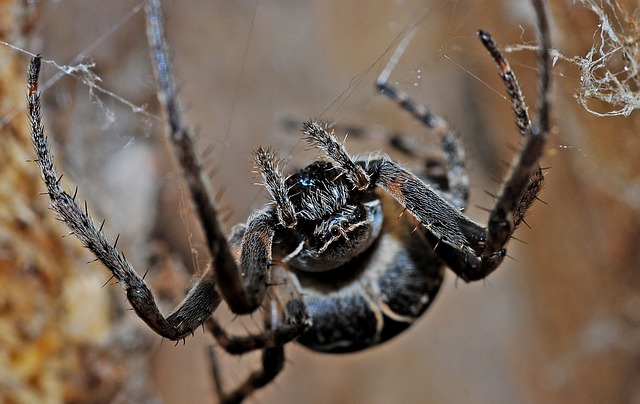
Spiders are downright creepy looking. With their spindly limbs, intricate webs, and dangerous reputation, it’s no wonder that for many people, the sight of a spider in their home will make their skin crawl. But are they truly dangerous? And of the common spiders in Washington State, which should cause genuine worry and which are essentially harmless?
Dangerous Spiders in Washington State
When we’re talking about dangerous spiders in Washington State, it boils down to two specific types of spiders.
Black Widows

Black Widows are probably the most notorious spider active in North America, and are common in eastern Washington, with just a few populations active here in western Washington according to the Department of Health.
Black Widow identification: These spiders are about half an inch long, and are identifiable by their black bodies and the distinctive red hourglass shape visible on the underside of their abdomens.
Black Widow bites: While their bites are quite venomous and can cause a serious and uncomfortable reaction, they are rarely fatal (despite their reputation).
Black Widow behavior: Black widows, like most spiders, are not especially aggressive – bites are rare, and usually only occur when the spider feels threatened.
Where Black Widows live: Black widow spiders prefer dark undisturbed areas, such as woodpiles, bales of hay, water meter boxes, under eaves, and fences. In homes, they are typically found in undisturbed, cluttered areas in basements, crawl spaces, or unused areas of garages.
Yellow Sac Spiders

Yellow sac spiders are mostly found in Eastern Washington and in the Seattle area, and they have a less venomous bite than our pal the black widow.
Yellow sac spider identification: Yellow sac spiders are small, measuring between ¼ inch and ½ of an inch in length. They are yellow or greenish, or white in color, with their color darkening around the legs and upper body.
Yellow sac spider bites: Yellow sac spider bites pose fewer health risks than black widow spider bites: bites are similar to that of a hornet, with significant initial pain and some redness and swelling. So while a bite is no doubt uncomfortable and painful, it poses fewer health risks than a black widow spider bite.
Yellow sac spider behavior: Yellow sac spiders are not aggressive creatures, but have been known to bite particularly when trapped against a person’s skin in clothing or bedding. They are also regular occupants of gardens during the spring and summer and can bite an unsuspecting gardener if they feel threatened.
Where yellow sac spiders live: As mentioned above, yellow sac spiders are frequently found in gardens during warmer months, but during the fall will sometimes make their way indoors, where they are typically found in the corners of walls and ceilings, behind shelves, and pictures, and along window sills.
Other Spiders in Washington State

Outside of the truly dangerous spiders in Washington, there are a number of other common spiders that frequent the Washington state area, including:
- Folding-door spiders
- Funnel weavers
- Cobweb spiders
- Cellar spiders (A.K.A. Daddy Longlegs)
- Wolf spiders
- Jumping spiders
- Orb weavers
- Crab spiders
While these spiders can be unpleasant to encounter and even appear to be scary or dangerous, the threats they pose to humans are minimal.
So Why Do Common Spiders Matter?
As we detailed, a vast majority of the spiders in Washington state pose a minimal health risk. In fact, many spiders have positive aspects for humans because their diet consists of common house pests like flies, moths, ants, mosquitoes, earwigs, and roaches. This sort of all-natural pest control can be a plus, but it comes with a caveat.
Firstly, while spiders may help manage some of the less-than-ideal insects lurking around your home, their presence is also an early warning that you likely have much bigger pest problems. Put more simply, if spiders are flocking to your home, they are doing so because the conditions of your home are friendly to them – and that includes other more problematic pests. Second, while spiders may provide some benefits, you simply may not want them in your home – particularly if you have kids or pets in the house.
Preventing Spiders
If you want to keep spiders out of your home, there are a few things that you can do to make the quieter, less climate-controlled parts of your home (like basements, attics, and sheds) less appealing to a spider.
- Routinely clean these parts of your home. Cleaning out the nooks and crannies of different parts of your home will get rid of any existing spiders and their eggs, and make the space less comfortable for them to live in.
- Cut the clutter. Cluttered areas create hidey holes for spiders and other pests, so keeping things tidy can make an area infinitely less appealing to these unwanted insects and arachnids.
- Spiders will be attracted to things in your lawn before they make their way indoors. Keep firewood, debris, and other stacked items away from your home’s foundation, and trim shrubs, vines, and trees that might be touching your home.
- Install tight-fitting window screens and door sweeps to exclude spiders and other pests.
Protecting Your Home From Spiders With Professional Pest Control
DIY prevention is always a great first step, but it is no guarantee that the measures you take will keep spiders and other more problematic pests out. That’s where The Pest Control Company comes in. With Home360, we provide ecologically conscious pest control that will keep your home protected year-round. Covering 40+ common pests, this plan keeps out spiders and the insects that attract them in the first place, among a host of other problematic pests. Just get in touch with us and we’ll start taking care of each and every one of your pest control needs ASAP!